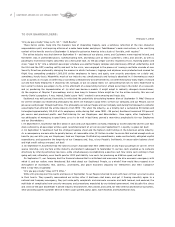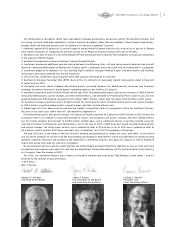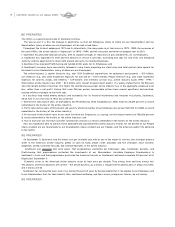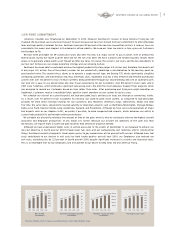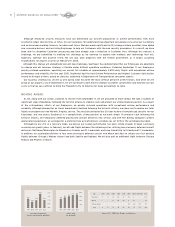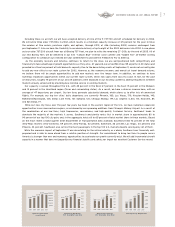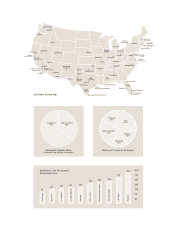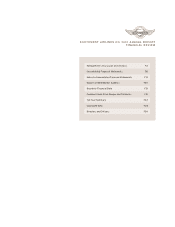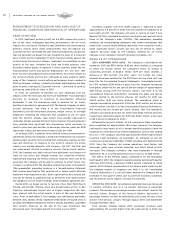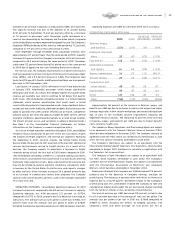Southwest Airlines 2001 Annual Report Download - page 12
Download and view the complete annual report
Please find page 12 of the 2001 Southwest Airlines annual report below. You can navigate through the pages in the report by either clicking on the pages listed below, or by using the keyword search tool below to find specific information within the annual report.
approximately $79.9 million and $113.5 million in gains from hedging
activities, respectively. The Company’s 2001 hedging gains were
calculated according to the requirements of Statement of Financial
Accounting Standards No. 133, as amended (SFAS 133), which the
Company adopted January 1, 2001. See Note 2 and Note 9 to the
Consolidated Financial Statements. As detailed in Note 9 to the
Consolidated Financial Statements, the Company has hedges in place
for approximately 60 percent of its anticipated fuel consumption in
2002. Considering current market prices and the continued effectiveness
of the Company’s fuel hedges, we are forecasting our first quarter
2002 average fuel cost per gallon to be below first quarter 2001’s
average fuel cost per gallon of $.7853. The majority of the Company’s
near term hedge positions are in the form of option contracts, which
should enable the Company to continue to benefit to a large extent
from a decline in jet fuel prices. (The immediately preceding two
sentences are forward-looking statements, which involve uncertainties
that could result in actual results differing materially from expected
results. Such uncertainties include, but may not be limited to, the
largely unpredictable levels of jet fuel prices, the continued effectiveness
of the Company’s fuel hedges, and changes in the Company’s overall
fuel hedging strategy.)
Maintenance materials and repairs per ASM decreased 3.2 percent.
This decrease was primarily due to the Company’s capacity growth
exceeding the increase in expense. Virtually all of the Company’s 2001
capacity growth versus the prior year was accomplished with new aircraft,
most of which have not yet begun to incur any meaningful repair costs. The
decrease in engine expense was partially offset by an increase in expense
for airframe inspections and repairs. In addition to an increase in the
number of airframe inspections and repairs, the cost per event
increased compared to 2000. Currently, the Company expects an
increase in maintenance materials and repairs expense per ASM in first
quarter 2002 versus first quarter 2001. (The immediately preceding
sentence is a forward-looking statement involving uncertainties that could
result in actual results differing materially from expected results. Such
uncertainties include, but may not be limited to, any unscheduled required
aircraft airframe or engine repairs and regulatory requirements.)
Agency commissions per ASM decreased 40.7 percent, primarily due to a
change in the Company’s commission rate policy. Effective January 1, 2001,
the Company reduced the commission rate paid to travel agents from ten
percent to eight percent for Ticketless bookings, and from ten percent to five
percent for paper ticket bookings. Effective October 15, 2001, the Company
reduced the commission paid to travel agents to five percent (with no cap),
regardless of the type of ticket sold. Due to this most recent commission
policy change in October 2001, we expect agency commissions to show a
year-over-year decrease in first quarter 2002 on a per-ASM basis. (The
immediately preceding sentence is a forward-looking statement involving
uncertainties that could result in actual results differing materially from
expected results. Such uncertainties include, but may not be limited to,
changes in consumer ticket purchasing habits.)
Aircraft rentals per ASM decreased 12.1 percent primarily due to a
lower percentage of the aircraft fleet being leased. Approximately 25.9
percent of the Company’s aircraft were under operating lease at
December 31, 2001, compared to 27.3 percent at December 31, 2000.
Based on the Company’s current new aircraft delivery schedule and
scheduled aircraft retirements for 2001, we expect a decline in aircraft
rental expense per ASM in 2002. (The immediately preceding sentence
is a forward-looking statement involving uncertainties that could
result in actual results differing materially from expected results. Such
uncertainties include, but may not be limited to, changes in the
Company’s current schedule for purchase and/or retirement of aircraft.)
Landing fees and other rentals per ASM increased 9.1 percent primarily
as a result of the Company’s expansion of facilities at several airports,
including Baltimore/Washington International Airport and Chicago
Midway Airport. As a result of the terrorist attacks, most other major
airlines have reduced their flight schedules and/or have retired aircraft
early due to the decrease in demand for air travel. Since Southwest has
not reduced the number of flights it offers, the Company expects that
the airport costs it shares with other airlines on the basis of relative
flights landed or passengers carried, such as landing fees and common
space rentals, will increase on a per-ASM basis in future periods. In
fourth quarter 2001, landing fees and other rentals per ASM increased
21.4 percent. The Company currently expects a similar year-over-year
increase in first quarter 2002. (The immediately preceding sentence is
a forward-looking statement involving uncertainties that could result
in actual results differing materially from expected results. Such
uncertainties include, but may not be limited to, changes in competitors’
flight schedules, demand for air travel, etc.)
Depreciation expense per ASM increased 4.3 percent primarily due
to the growth in the Company’s aircraft fleet prior to the September 11,
2001, terrorist attacks. The Company had received delivery of 14 new
737-700 aircraft prior to September 11, bringing the percentage of
owned aircraft in the Company’s fleet to 74.1 percent by the end of
2001 compared to 72.7 percent at the end of 2000.
Other operating expenses per ASM increased 3.5 percent primarily due
to a significant increase in passenger liability, aircraft hull, and
third-party liability insurance costs following the terrorist attacks. The
Company’s insurance carriers cancelled their war risk and terrorism
insurance policies following the terrorist attacks and reinstated such
coverage at significantly higher rates than before. Although the
Company was reimbursed for a portion of the higher rates by the federal
government for one month during fourth quarter 2001, we have
assumed no further reimbursements. As a result, the Company
currently expects continued year-over-year increases in insurance
costs for the near future, including first quarter 2002. (The
immediately preceding sentence is a forward-looking statement involving
uncertainties that could result in actual results differing materially
from expected results. Such uncertainties include, but may not be
limited to, the financial stability of companies offering insurance
policies to the airline industry, the level of competition within the
insurance industry, etc.)
OTHER “Other expenses (income)” included interest expense,
capitalized interest, interest income, and other gains and losses. Interest
expense was flat compared to the prior year. Following the
terrorist attacks, the Company borrowed the full $475 million available
under its revolving credit facility and issued $614.3 million in long-term
debt in the form of Pass-Through Certificates (see Note 7 to the
Consolidated Financial Statements). The increase in expense caused by
these borrowings was offset by a decrease in interest rates on the
Company’s floating rate debt and the July 2001 redemption of $100 million
of unsecured notes. Based on the Company’s recent borrowings, we
expect interest expense to be higher on a year-over-year basis
in first quarter 2002. (The immediately preceding sentence is a
forward-looking statement involving uncertainties that could result in
actual results differing materially from expected results. Such
uncertainties include, but may not be limited to, subsequent financing
decisions made by the Company.) Capitalized interest decreased 25.3
percent primarily as a result of lower 2001 progress payment balances for
scheduled future aircraft deliveries compared to 2000. The lower
progress payments were due in part to the deferral of Boeing 737 aircraft
SOUTHWEST AIRLINES CO. 2001 ANNUAL REPORT
F4


